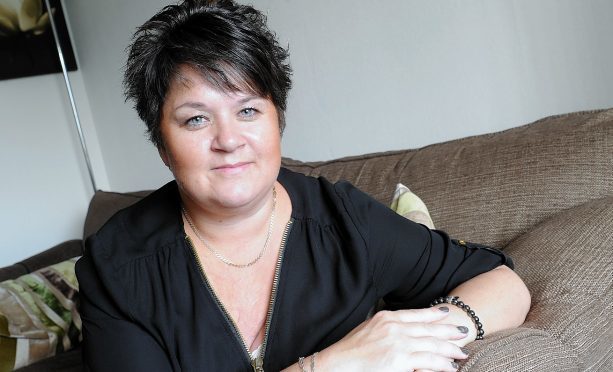A woman has spoken of the moment she came within seconds of death due to a terrifying condition which makes every day a game of “Russian Roulette”.
Just walking past a child’s balloon or driving by a field of wheat could prove fatal for Sandra Hercher because she suffers from severe allergic reactions called anaphylaxis.
And last week the worst fears of the 41-year-old from Inverness were almost realised when she become seriously ill while driving on the north’s busiest road – only for her life to be saved by a quick-thinking paramedic.
Now the former auxiliary nurse has lifted the lid on her daily battle to survive in an attempt to raise awareness of the condition.
Latex, peanuts and wheat are all potential killers for Miss Hercher, but she does not even have to touch them – the threat can be carried through the air.
Within minutes of a reaction, anaphylaxis sufferers can experience an itchy rash, throat or tongue swelling, shortness of breath, vomiting, lightheadedness and low blood pressure.
Miss Hercher was only diagnosed a year-and-a-half ago, but has already had eight or nine serious reactions, with the worst almost claiming her life as she drove over the Cromarty Bridge.
“What they possibly think happened is that I passed a field that was being harvested and I went into anaphylaxis on the Cromarty Bridge,” she explained to the Press and Journal.
“I tried to get back to Inverness because what happens is that you don’t have the ability to speak so I couldn’t phone an ambulance.
“I pulled over in a layby just after the Cromarty Bridge and tried to take my medication. I knew at that point that I was in trouble.
“I could hardly breathe. I knew that I didn’t have time to sit at the side of the road and wait for an ambulance. There were cars that passed me and I was sitting at the side of the road but they didn’t stop.
“Admittedly I probably shouldn’t have driven but it probably saved me at the end of the day.”
Miss Hercher believes she may not be around today if it was not for the fact that there happened to be no delays on the Cromarty Bridge, which is currently undergoing upgrade work, and her decision to drive to her daughter’s home in Dalneigh rather than her own in Muirtown.
Then there was the quick thinking of paramedic Kevin Peat.
“He had to ventilate me in the back of the ambulance. I remember them having to pull the ambulance over,” she said.
“I can remember him speaking to me. He was behind doing the pumps for my lungs. I remember him telling me his name and that he was going to help me. That’s the last thing I remember.”
After recovering at the city’s Raigmore Hospital, where she used to work, Miss Hercher took to social media to find Mr Peat and thank him for his actions.
“I’ve had anaphylaxis before but never to the stage where I thought ‘this is it’,” she said.
“I just felt the need to find him and thank him. He definitely saved my life. I’ve got two grandchildren and I’m a single parent of three – I’m so grateful to him.
“He was in the right place at the right time, and maybe another paramedic wouldn’t have done the same as him. He made it possible that I’m here today, as well as everybody in the hospital.”
Miss Hercher decided to speak about her condition to help increase public understanding of the seriousness of such allergies.
“A couple of weeks ago a girl passed me holding a balloon and it happened. Somebody sat beside me wearing latex gloves and I had a reaction,” she said.
“In some restaurants staff wear latex gloves and if I ask them to remove them they look at me, but it’s my life.
“It just progressively gets worse. I’m waiting to see a specialist but there’s only two in Scotland.
“Walking about every day is like playing Russian Roulette thinking ‘is today the day’. I try not to let it get to me, because if I did I would never leave the house.
“It’s getting harder and harder. My worry is the next one won’t have as good an outcome.”
A Scottish Ambulance Service spokesman said: “Our highly skilled paramedics and technicians are treating patients and saving lives in communities across Scotland every day.
“It is great when the work of our crews is recognised through positive feedback, and we wish the patient a full and speedy recovery.”
How to spot signs of anaphylaxis
A top Highland doctor has urged anyone who spots the signs of anaphylaxis to dial 999 immediately.
Dr Ken McDonald, associate medical director for Raigmore Hospital, said: “Anaphylaxis is a medical emergency and can be very serious if not treated quickly.
“If you think someone has symptoms of anaphylaxis dial 999 for an ambulance immediately.
“If you have experienced anaphylaxis or have a serious allergy it is important to try and prevent it from happening again.
“Referral to an allergy clinic may identify triggers and, once identified, it is important to avoid them whenever possible.
“People who have had confirmed severe anaphylactic reactions should also carry an adrenaline auto-injector with them all the time.”
Symptoms can include generalised flushing of the skin, nettle rash (hives) anywhere on the body, sense of impending doom, swelling of throat and mouth, difficulty in swallowing or speaking, alterations in heart rate, severe asthma, abdominal pain, nausea and vomiting, sudden feeling of weakness (drop in blood pressure), collapse and unconsciousness.
